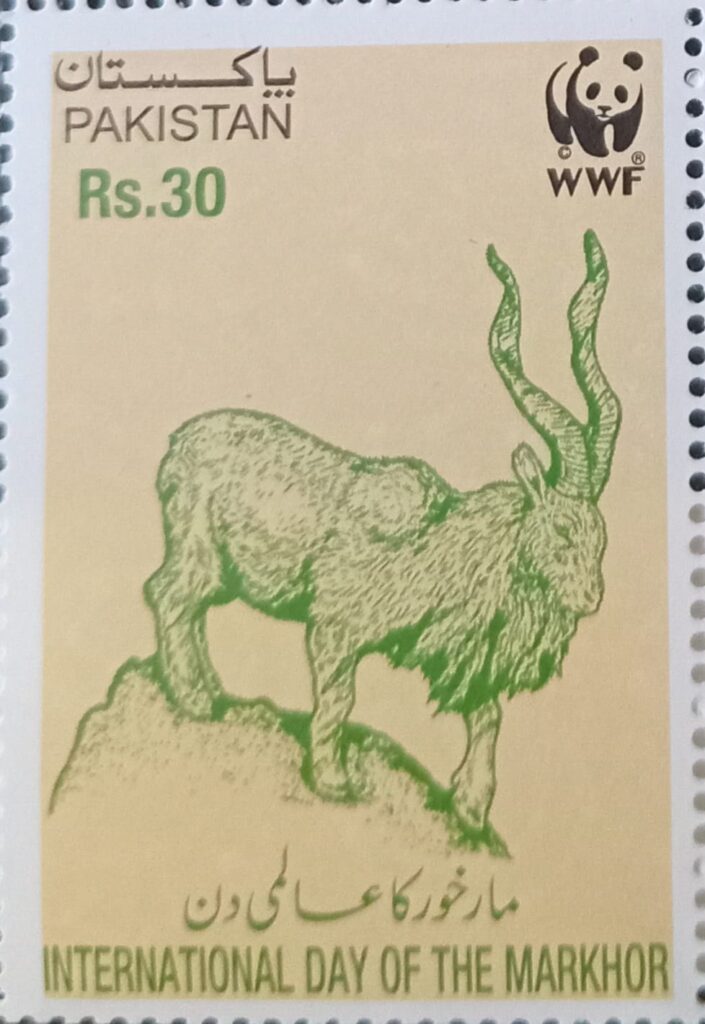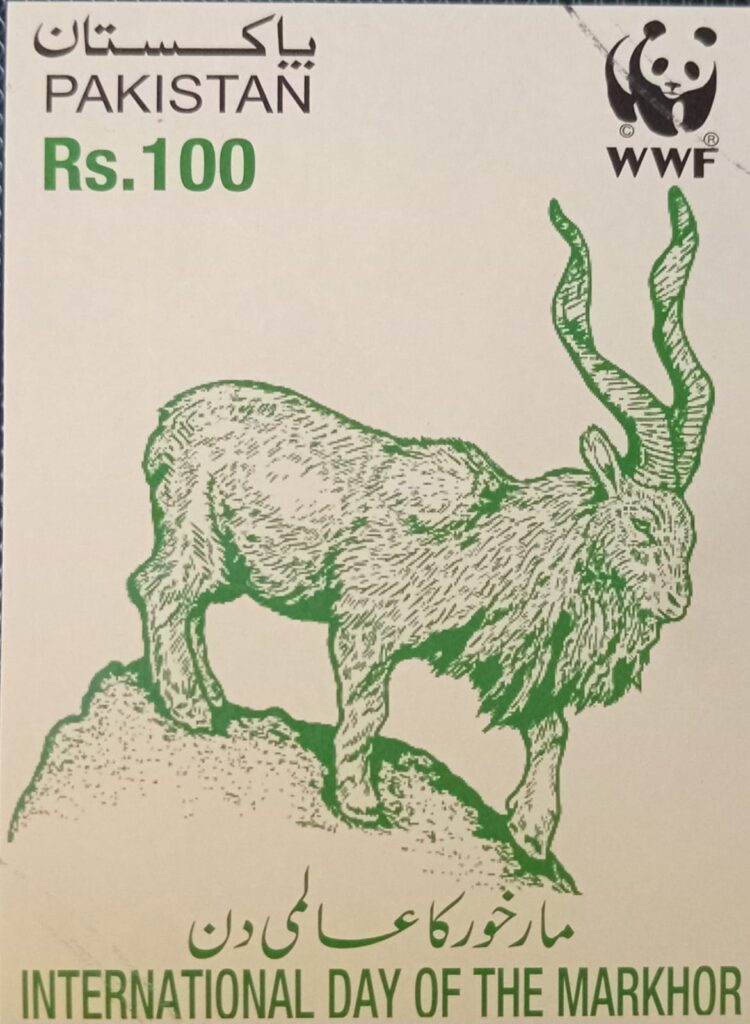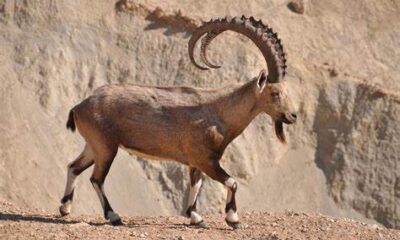Article
INTERNATIONAL DAY OF THE MARKHOR COMMEMORATIVEPOSTAGE STAMP AND SOUVENIR SHEET. MAY24,2024
Published
1 year agoon
By
EDITOR
SALIENT FEATURES
Size of Stamp : 50.5 x 35 mm
Size of Print : 47 x 32 mm
Number of Stamps
in a sheet: 6 x 3 = 18 stamps
Perforation : 13 C.
Denomination : Rs. 30/-
Size of Souvenir Sheet : 105 x 72 mm
Denomination of Souvenir Sheet : Rs. 100/-
Colours : Special Color
Printing Technology : Lithography Offset
Paper : 100 GSM Water Mark Gummed Paper
Gum: PVA
Quantity Stamps : 0.2 Million (2 Lac)
Quantity of Souvenir Sheet : 25,000
Design : Supplied by the Customer
Printer : National Security Printing Company, Karachi.
The Markhor (Capra falconeri), the national animal of Pakistan, is a large wild goat species native to South Asia and Central Asia, mainly within Pakistan, India, the karakoram range, parts of Afghanistan, and the Himalayas. Since 2015 it has been classified as Near Threatened on the IUCN Redlist. The word “Markhor” meaning “Snake-eater,” originates from Pashto and classical Persain languages, reflecting the ancient belief that the Markhor would hunt and eat snakes. This regional myth likely arises from the male Markhor’s horns, which twist and curl in a snake-like manner, leading ancient peoples to associate them with snakes. There are five sub-species of Markhor (Capra falconeri) namely Astor Markhor or AstorAstore Markhor (Capra falconeri), Bukharan Markhor (Capra falconeri heptneri), Kabul Markhor (Capra falconeri megaceros), Kahmir Markhor (Capra falconeri cashmiriensis) and Suleiman Markhor (Capra falconeri jerdoni), often based on their horn configuration.
As true goats of the Himalayas, the Kashmir Markhor (Capra falconeri cashmiriensis) is the most spectacular among wild goats. Distinguished by its large body, long spiraling horns, thick fur, and a flowing beard and neck ruff. It is widely spread from Afghanistan to Pakistan, Azad Jammu and Kashmir and Indian occupied jammu and Kashmir. In Pakistan, Kashmir Markhor, around Chitral and the border areas with Afghanistan, inhabits a number of valleys along the Kunar River (District Chitral), from Arundu on the west bank and Drosh on the east bank, upto Shoghor along the Lutkho River, and as far as Barenis along the Mastuj River. In Dir district, the Markhor accurs along the upper Panjkora River, on the slopes of Ludak Sar and Mankial in Swat and in Indus Kohistan. Its isolated populations also occur in Azad Jammu and Kashmir in the western extremity of the Kazinag Range.
The main predators of the Markhor include the Eurasian lynx (Lynx lynx), snow leopard (Panthera uncial), Himalayan wolf (Canis lupus chance), and brown bear (Ursus arctos). Young Markhors are also preyed upon by the golden eagle (Aquila chrysaetos). Markhor have sharp eyesight and a strong sense of smell, which help them detect nearby predators. They are highly alert and aware of their surroundings, quickly spotting and feeling from threats in exposed areas.
Markhor in Pakistan faces numerous threats that jeopardi1e its survival Habitat loss due to d forestation, agricultural expansion, and infrastructure development significantly reduces the areas where these wild goats can’t live and forage. Additionally, illegal hunting and poaching, driven by the high value of their distinctive spiraled horns, have led to a dra tic decline in their population. Competition with domestic livestock for food and water resources further strains their already limited habitat. Climate change also poses a growing threat, altering the delicate balance of their mountainous ecosystems. These challenges collectively threatened the Kashmir Markhor, highlighting the regent need for comprehensive conservation efforts to protect and preserve this iconic species.
The United Nations General Assembly (UNGA) has officially declarE:d May 24th as the International Day of the Markhor, following a resolution sponsored by Pakistan and eight other countries. This significant move aims to promote global awareness and cooperation for the conservation of the Markhor. The resolution urges all stakeholders to prioritize efforts
to protect the Markhor and its natural habitat, recognizing its ecological importance and potential for enhancing regional economies through sustainable tourism and conservation initiatives.
On the occasion of declaration of International Day of the Markhor by the UN, a Commemorative Postage Stamp of Rs. 30/- denomination
and Souvenir Sheet (Value of Rs. 100/-) are being issued by Pakistan Post on 24th May 2024.



TERMS OF SALE
This Commemorative Postage Stamp will be available for sale from 24th May, 2024 at all important Post Offices in the country.
Overseas orders for Stamps, First Day Issue Covers and Leaflets should beaddressed to the Manager, Philatelic Bureau, Karachi GPO or Manager,National Philatelic Bureau, Islamabad GPO, accompanied by a Bank Draft or Crossed Cheque encashable in Pakistan.
Issued by
THE DIRECTOR GENERAL, PAKISTAN POST, ISLAMABAD.
You may like
-


Unity, Faith, and Discipline: The Cornerstones of Pakistan’s Motto as “Aik Qaum” (One Nation)
-


Aik Qaum: The Fusion of Integrity and Patriotism
-


“AIK QAUM” DECLARATION OF CONCEPTION
-


Dr. Abdul Qadeer Khan: The Real Hero of Pakistan
-


The Chiltan Ibex: A Rare Treasure of Balochistan
-


MANGO HEALTH BENEFITS NUTRITION
Article
Aik Qaum: The Fusion of Integrity and Patriotism
Published
3 weeks agoon
May 28, 2025By
EDITOR
We keep Integrity closest to our Heart and Patriotism on top of our mind.
Integrity and patriotism are not separate entities; they are intertwined in the soul of Pakistan. The people understand that to be a patriot is to uphold the principles of integrity. Honesty and love for one’s country are two sides of the same coin. Together, these values form the essence of “Aik Qaum.”
The fusion of integrity and patriotism is evident in the everyday lives of Pakistanis. It’s in the farmer toiling the fields, the teacher educating the youth, and the soldier guarding the borders. It’s in the child who dreams of a better Pakistan and the elderly who have seen the nation grow. “Aik Qaum” is the realization that integrity and patriotism are the heart and mind of Pakistan, beating in unison to guide the nation forward.
As we celebrate the spirit of “Aik Qaum,” we honor the values that make Pakistan a unique and resilient nation. Integrity and patriotism serve as our guiding stars, leading us towards a brighter and more prosperous future. In the heart of every Pakistani and at the forefront of their minds, “Aik Qaum” stands as a testament to the strength of a united nation, bound by the principles of integrity and the unyielding love for their homeland.
In Pakistan, “Aik Qaum” is not just a motto; it’s a way of life that embodies the enduring spirit of a proud and united nation.

Our Initiative
The fabric of the Pakistani nation has something unique in its knit, something signature and so sanguine that could keep on energizing its very fibers irrespective of the floods of considerably tough challenges posed against it since its inception. There is also a belief that Pakistan has been blessed with such a golden glitter that couldn’t be ignored by any sensible system of reason and knowledge among the league of free, upright and kind nations. The credit goes to the amazing people of Pakistan. It is more exciting to find that the people of Pakistan, be it the businessmen, doctors, parents, soldiers, students, teachers, judges, labourers or lawyers etc, have assumed the duty bestowed upon them by the founder of the nation, Quaid-e-Azam Muhammad Ali Jinnah decades ago. Quaid once said “If you will work in cooperation, forgetting the past, burying the hatchet, you are bound to succeed.” At another occasion, Quaid summed this message up in just three words: Unity, Faith and Discipline. AIKQAUM.COM is an initiative built upon the idea of translating this vision of the founder of Pakistan, Quaid-e-Azam Muhammad Ali Jinnah into a fruitful action.
There is no power on earth that could restrict us from finding those beautiful commonalities among the people of this beautiful nation. It contends to promote the psyche morale of the Pakistani nation by addressing the issues instead of dodging them. We have a team of thorough professionals fully equipped to create unique platforms, forums and projects which will bring people closer on all sensitive issues related to our national identity and progress. We also have a strong support network for successful execution of all our campaigns in order to induce greater cohesion and the spirit of coexistence across the length and breadth of Pakistan. Coincidentally, we are living through an age of increased morphing of warfare in a world that’s once again moving from unipolar to a multipolar turf. The social, political, economic and technological factors shaping the evolution of warfare are being constantly experimented and employed in our own region. In a time of increased friction between regional powers and a heightened threat on the eastern border, Pakistan faces multiple challenges posed at its internal, external and economic security.
All these factors, blended with our archrival’s constant image building campaigns, a heavily funded lobbying in the West, the new Indo-US strategic alliance, as well as India’s ambition to start a space race, puts our nation on caution and throws immense burden of responsibility on our shoulders. We are witnessing a rise of sub conventional warfare fought with guns and bombs, but won on keyboards and drawing boards. AIKQAUM.COM aspires to be a strong force of defense against the subversive forces that are trying to malign Pakistan and hurt our interests in the region. We are fully trained and equipped to meet the challenges on the social and digital front.
www.aikqaum.com, info@aikqaum.com
Our Philosophy
VISION:
To create a social awareness about the values which join our nation together while countering anti-Pakistan narratives with logical and practical rationale.
MISSION:
To infuse a sense urgency for cohesion among all ethnic, political and religious schools of thought.
VALUES:
We keep integrity closest to our heart and patriotism on top of our mind. Our work ethics and commitment to our people shall empower us to achieve success in all our pursuits.
Article
The Chiltan Ibex: A Rare Treasure of Balochistan
Published
2 months agoon
April 16, 2025By
EDITOR
The Chiltan ibex (Capra aegagrus chiltanensis), a subspecies of the wild goat, is one of the most unique and endangered animals native to Pakistan. Found exclusively in the rocky highlands of the Chiltan range within the Hazarganji-Chiltan National Park in Balochistan, this elusive animal represents the region’s rich biodiversity and ecological heritage.
Physical Characteristics
The Chiltan ibex is a strikingly beautiful species, with a robust, muscular build perfectly suited for navigating steep and rocky terrains. Males are particularly distinctive, boasting impressive curved horns that can grow up to 30 inches (76 cm) in length. Their coat is light brown, with a darker stripe running along their back and legs, providing excellent camouflage in their arid mountainous habitat.
Females are smaller in size with shorter, more slender horns, and their coloration is less pronounced, blending seamlessly into their surroundings. This camouflage helps protect them and their offspring from predators such as wolves and large birds of prey.
Habitat and Range
The Chiltan ibex inhabits the rugged, semi-arid regions of the Chiltan range, located within the Hazarganji-Chiltan National Park, southwest of Quetta. These high-altitude areas, ranging from 1,500 to 3,200 meters above sea level, are characterized by rocky cliffs, sparse vegetation, and extreme weather conditions.
The ibex is well-adapted to this challenging environment, where it feeds on grasses, shrubs, and the leaves of juniper trees. Its ability to climb steep slopes and jump across narrow ledges gives it a unique advantage in escaping predators and surviving in such inhospitable terrain.
Behavior and Social Structure
Chiltan ibexes are diurnal, meaning they are active during the day. They are typically found in small groups, with herds consisting of females and their young. Males are more solitary, joining herds only during the breeding season, which occurs in the late autumn and winter months.
During this time, males engage in dramatic displays of strength to compete for mating rights, including horn clashing and dominance rituals. After a gestation period of around six months, females give birth to one or two kids in spring, when food availability is higher.
Conservation Status
The Chiltan ibex is classified as endangered due to its restricted range, habitat loss, and poaching. Habitat degradation caused by overgrazing, deforestation, and human encroachment poses significant threats to its survival.
Historically, the ibex faced heavy hunting pressure for its horns, considered a symbol of prestige, and for its meat. Although hunting is now banned in the national park, illegal poaching remains a concern.
Conservation Efforts
To protect the Chiltan ibex and its fragile ecosystem, the Hazarganji-Chiltan National Park was established in 1980. Spanning over 32,500 acres, the park provides a safe haven for the ibex and other wildlife, such as wolves, foxes, and birds of prey.
Conservation efforts include:
- Anti-Poaching Measures: Increased patrolling and strict enforcement of hunting bans have helped reduce poaching incidents.
- Habitat Restoration: Programs to control overgrazing and reforest juniper woodlands are underway to restore the ibex’s natural habitat.
- Public Awareness Campaigns: Local communities are being educated about the importance of biodiversity and the role of the Chiltan ibex in maintaining ecological balance.
- Eco-Tourism Initiatives: Promoting responsible tourism generates revenue for conservation projects and raises awareness about the ibex’s plight.
Ecological Importance
The Chiltan ibex plays a vital role in its ecosystem as both a grazer and prey species. By feeding on shrubs and grasses, it helps maintain vegetation balance, preventing overgrowth and contributing to soil health. At the same time, it serves as a food source for predators, sustaining the natural food chain.
Protecting the ibex is not just about saving a single species—it’s about preserving an entire ecosystem that supports numerous forms of life, from tiny insects to apex predators.
Cultural Significance
For the people of Balochistan, the Chiltan ibex is more than just a wild animal; it is a symbol of the region’s natural beauty and resilience. Local folklore often intertwines with the ibex, celebrating its agility and strength. The species also draws international attention, making it a flagship for wildlife conservation in Pakistan.
The Future of the Chiltan Ibex
While conservation efforts have shown promise, the Chiltan ibex remains vulnerable. Protecting this rare species requires continued collaboration between government agencies, conservation organizations, and local communities.
By safeguarding the Chiltan ibex, we not only preserve a unique animal but also protect the fragile ecosystem of Balochistan, ensuring that future generations can marvel at the beauty and resilience of this incredible species.
The Chiltan ibex is a testament to nature’s ability to adapt and survive in the harshest of environments. As efforts to protect it continue, this majestic animal stands as a beacon of hope for wildlife conservation in Pakistan.

Unity, Faith, and Discipline: The Cornerstones of Pakistan’s Motto as “Aik Qaum” (One Nation)

Aik Qaum: The Fusion of Integrity and Patriotism








